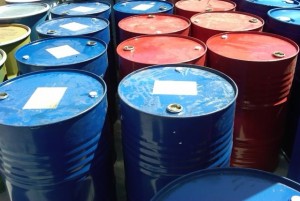 West Texas Intermediate crude trimmed its daily gains and Brent remained on negative territory during late European trading as rising gasoline and distillate fuel inventories offset better-than-expected US GDP growth in the second quarter. Geopolitical tension in several key regions continued to be a supportive factor, albeit to a lesser extent.
West Texas Intermediate crude trimmed its daily gains and Brent remained on negative territory during late European trading as rising gasoline and distillate fuel inventories offset better-than-expected US GDP growth in the second quarter. Geopolitical tension in several key regions continued to be a supportive factor, albeit to a lesser extent.
On the New York Mercantile Exchange, WTI crude for delivery in September traded at $100.99 per barrel at 14:55 GMT, up 0.02% on the day. Prices shifted in a daily range between $101.67 and $100.76 a barrel. The US crude benchmark fell to a two-week low of $100.37 on Tuesday and closed the day 0.69% lower at $100.97.
Meanwhile on the ICE, Brent futures for delivery in the same month were down 0.22% to trade at $107.48 a barrel, having varied between day’s high of $107.86 and low of $107.31 a barrel. The contract rose by 0.14% on Tuesday to settle at $107.72. Brent traded at a premium of $6.49 to its US counterpart, down from Tuesday’s close at $6.75 which was the widest since July 4th.
The Energy Information Administration reported that US crude oil inventories fell for a fifth week by 3.7 million barrels to 367.4 million in the seven days through July 25th, exceeding forecasts for a 1.25-million drop. Supplies at Cushing, Oklahoma, the biggest US storage hub, dropped to 17.9 million barrels, the lowest since October 2008, down from 18.8 million a week earlier.
However, the oil market was pressured down as the government agency also said that motor gasoline inventories, closely monitored during the peak summer driving season, rose by 0.4 million barrels to 218.2 million, the highest since March. This was below analysts projections for a 1-million jump, but also trailed APIs data which showed on Tuesday a 60 000-barrel increase.
Distillate fuel inventories, which include diesel and heating oil, rose by 0.8 million barrels to 126.7 million, compared to anticipations for a 1.5-million increase.
Refineries operated at 93.5% of their operable capacity. Both gasoline and distillate fuel production decreased last week, averaging over 9.3 and 5.0 million barrels per day.
The bearish sentiment couldnt be lifted even by as the Commerce Department reported that the US economy grew more than expected in the second quarter, while the first quarters 2.9% contraction was revised up to show -2.1%. In the three months through June, the worlds biggest economy expanded by 4.0%, exceeding economists forecasts for a 3.0% growth.
Meanwhile, consumer spending, the biggest part of the economy, rose by 2.5%, reflecting the biggest gain in purchases of durable goods in nearly five years.
Market players now turned their attention toward the remaining crucial data for the week, as well as the conclusion of FOMCs two-day policy meeting due later today, in order to gauge demand prospects.
On Thursday, we are likely to see a moderate jump in initial jobless claims for the week through July 25th, but they are likely to remain in the shadow of Friday’s non-farm payrolls and unemployment rate for July. US employers are likely to have added 230 000 jobs this month, compared to 288 000 in June, while the unemployment rate is anticipated to have remained flat at 6.1%.
Also due on Friday are the Markit Economics Manufacturing PMI, projected to come out unchanged, the ISM Manufacturing Report on Business and the Reuters/Michigan Consumer Sentiment Index, both expected to have marked an improvement.
Geopolitical tension
Ongoing geopolitical turmoil in several key regions of interest for the oil market kept a floor under prices, although the lack of fear of any changes to global supply kept support limited.
EU leaders agreed yesterday on their toughest sanctions against Russia to date, limiting the export of equipment used to modernize the oil industry and prohibiting the sale of equipment for military purposes, as well as barring state-owned banks from selling bonds or shares in Europe. Several hours later, the US imposed sanctions on three Russian banks and a state-owned shipbuilding company. The focus now fell on President Vladimir Putin’s response to the new round of penalties.
Elsewhere on the geopolitical scene, a Libyan official said that nationwide crude output is at around 500 000 barrels per day, in spite of the escalating violence in Tripoli. The Libyan government said on Monday that an oil depot near Tripoli’s international airport caught fire during clashes between rival militias, and sought international help.
In Iraq, conflicts with Islamist militants in the north left oil production in the country’s south untouched, keeping oil exports unhaffected at record-high levels.
Meanwhile, clashes in the Gaza strip seemed to have no prospects of being ended soon. Israeli Prime Minister Benjamin Netanyahu warned earlier in the week of a prolonged war after the latest attack from Palestinian fighters.





